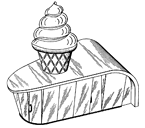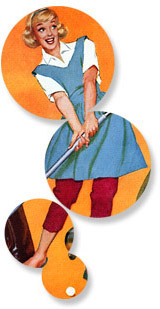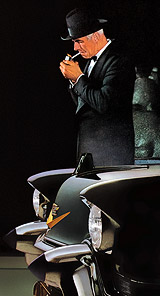SATURDAY, APRIL 28, 2007
The colorful Dynamic Series Oldsmobiles for 1948 offer the discriminating buyer an exceptionally wide choice in body styles, power plants and extra value features. There are seven basic body designs — five “60’s” — two “70’s” . . .
From the 1948 sales catalogue, the “Dynamic” species of the extinct genus known as Oldsmobilus Americanus, arrayed as colorfully as a box of bonbons.
WEDNESDAY, APRIL 25, 2007
≈
Olds Series 60 Convertible Coupe
![]()
Just push a button — and this weathertight, 6-passenger Convertible is instantly transformed into a smart open roadster. The snug-fitting top is power-operated from a convenient switch on the dash. This model available with genuine leather upholstery, or with colorful leather and cloth combination.
Editorial: Modern advertising needs more illustrations like this. Warm up the airbrush, dust off the Rapidograph and chuck that Mac out the window.
Six passengers can ride in real comfort in this colorful Club Sedan. Its dashing smartness combines the appearance of a larger car with the convenience of a coupe. Its sweeping rear deck conceals a really spacious luggage compartment.
The Olds “Dynamic” lineup for 1948 offered five Series 60 cars (club sedan, club coupe, four-door sedan, convertible, station wagon) and two Series 70 models (club sedan, four-door sedan), with two engine choices (Olds 66 and 76, with six cylinders, or the eight-cylinder Olds 68 and 78). The senior 90 Series “Futuramic” line comprised three body styles under one name with an eight-cylinder engine, the Olds 98. For 1949, the Dynamic name disappeared when the lower-series cars got the division’s “Futuramic” bodies. Series 70 cars dropped the 78, leaving only the Olds 76 and its six-cylinder motor, while a revived Series 80 offered only eights, that model being the famed Olds 88.
TUESDAY, APRIL 24, 2007
≈
Oldsmobile Series 6o Station Wagon
![]()
This sleek looking, sturdily built Station Wagon combines handsome styling for town travel and handy adaptability for country use. Comfortable, leather-upholstered seats can carry eight passengers without crowding, or both rear seats can be removed to haul loads of up to a thousand pounds.
An illustration from the 1948 Oldsmobile catalogue, in the days when station wagons had wood-bodied passenger compartments framed with ash and, as the name implies, were largely used for hauling people and their luggage from the train station.
MONDAY, APRIL 23, 2007
“Dynamic” is more than just another name as applied to these new Oldsmobiles for 1948. It’s an action-word that’s particularly suited to the “personality” of these action-styled, action-engineered cars. The very smoothness of their flowing lines suggests motion . . . driving . . . travel . . . excitement. Sparkling new colors, inside and out, heighten this effect and give an added impression of dynamic smartness — smartness that stays in style as other fashions change.
Today’s selection is the cover for the 1948 Oldsmobile “Dynamic” Series 60 and 70 sales brochure, as opposed to the newer-bodied “Futuramic” Series 90 (Olds 98). The Dynamic tag disappeared the following year when the Series 80 (Olds 88) debuted, but was revived a decade later for the 1958 Dynamic 88.
FRIDAY, APRIL 20, 2007
This “hard-top convertible” will score with fans! No matter what the weather outside, football and other events can be enjoyed here under ideal conditions of temperature, humidity and lighting, day or night. The giant coliseum will also house theatres, shops, restaurants, parking areas . . . even a nursery. At least one mammoth center like this is already being built . . .
Once upon a time, kids, the future was actually futuristic instead of the ho-hum World of Today it turned out to be. Vanadium, and Jetsonistic parking ramps, were expected to play a part.
FRIDAY, APRIL 13, 2007
ATLAS utilizes a radio-command guidance system provided by General Electric’s Defense Systems Department. Depicted here is the dramatic blastoff of the ATLAS launch which — under radio-command guidance — produced a successful earthly orbit as part of project SCORE . . .
Project SCORE (Signal Communications Orbit Relay Equipment), the first communications satellite, was launched on an Atlas rocket in December 1958 (which, incidentally, is also the launch date of your webmaster). An onboard tape recorder broadcast a Christmas message from President Eisenhower. The 1959 illustration is by the aviation and space artist Robert McCall.
≈
Sunken Treasure — Everywhere!
![]()
Down under the sea, where sunlight never creeps, miners soon may be working the world’s biggest “strip mine.” For large areas of the ocean floor are covered with nodules of manganese and other minerals — a treasure trove too precious to overlook! Huge hydraulic dredges, working like vacuum cleaners, will draw ore up to a barge, supervised by bathyscaphes and submarines . . .
A vision of inner space by the artist Jo Kotula, also from 1959, for Vanadium Corporation of America.
MONDAY, APRIL 9, 2007
Here is a versatile thermoplastic sheet material that forms to any shape in sharp detail, and still answers the basic design problems of toughness, beauty and economy. Used as a tool for advanced thinking, U.S. Royalite makes new, modern product designs practical . . .
An unsigned illustration for United States Rubber from 1960 that right away set off our Radebaugh detector. We especially like the clamshell TV. And lawnmower with tailfins.
You travel first class in a Catalina with so many extra driving conveniences that comes as regular equipment in a Pontiac. Electric wipers, dual visors, foot- operated parking brake, automatic interior lighting, dual armrests front and rear, crank-operated ventipanes, foam front seat padding, full carpeting . . .
Armrests on the doors, front and rear? Two sun visors? At no extra cost? Pinch us, we must be dreaming. From the 1962 Pontiac sales brochure, another nice illustration by Art Fitzpatrick and the late Van Kaufman.
TUESDAY, APRIL 3, 2007
Lane marking colors you can roll on like magic . . . let your trucks wheel over them right away! “Scotch” Brand Plastic Tape No. 471 revolutionizes lane marking — and no wonder! It sticks at a touch to any clean, dry surface . . .
From 1955, the adhesive tape that almost looked good enough to eat. And would probably stick to your ribs.
It takes a special rubber to keep up with the table tennis trade. Those hundreds of tiny rubber nubbins on the paddle enable the player to put plenty of spin, or “English,” on the ball. The manufacturer of this material, Hodgman Rubber, turned to Ameripol to meet these requirements. Since Ameripol 1013 is highly plastic in the processing stage, it proved to have ideal flow characteristics. And with this light polymer, it can be made in a variety of gay colors . . .
Tiny gay rubber nubbins never looked so good as they did in this 1960 illustration of a future Ping-Pong champ.
PREVIOUS POSTS (MARCH 2007) • SITE © 1999-2020 PLAN59.COM








